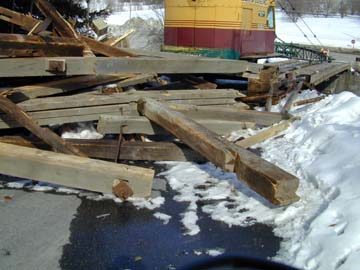
Power House Covered Bridge Removed from River

March 16, 2001 - Blow and Cote, contractors from Morrisville, have pulled the timbers and debris out of the Gihon River and stacked it all for sorting and hauling.
Notice the tenon at the top of the queenpost. This fit into a mortise in the bottom of the plate timber that ran the length of the bridge supporting the ends of the roof rafters. The plates were mortised above each queenpost to receive the tie-beam tenons.
This writer observed three kinds of damage to the joints between the plates and the tie-beams:
- The tenon was pulled out of the mortise, breaking the pegs holding them together;
- The "relish" was broken out of the mortise leaving the pegs intact in the tenon;
- The "relish" on the tenon was pulled out leaving the mortise and pegs intact.
This damage was done by the weight of the snow load pressing down on the rafters, turning the rafters into levers that forced the tie-beam joints apart. The bridge might have been able to support the snow load if collar ties or steel tie-rods were used to augment the tie-beam connections.

Photo by Joe Nelson
March 16, 2001
In this photo, one of the down-stream queenposts can be seen still attached to the chord. The queenpost brace and the counter-brace are nearby, strung on the queen-rod still bolted to the chord. Notice the stub of the floor beam, sawed off short to make way for the steel beams that independently supported the bridge floor. This change was probably made in one of the later reconstructions.
